
Concept explainers
(a)
Interpretation:
The molecular formula of peramivir should be determined.
Concept Introduction:
Peramivir is an antiviral drug which is used in the treatment of influenza. It is a neuraminidase inhibitor which inhibits the transition state of the influenza so that it does not produce new viruses from the infected cells.
Molecular formula of a molecule represents the total number of atoms present in the molecule.
Answer to Problem 43P
C15 H28 N4 O4.
Explanation of Solution
The structure of the molecule is as follows:
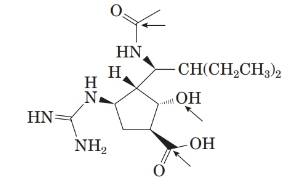
From the structure, the molecular formula of the compound is C15 H28 N4 O4.
(b)
Interpretation:
The
Concept Introduction:
Functional group of a compound represents its chemical properties. The most common organic functional groups are alcohol,
In amines, the alkyl group is attached to the nitrogen atom having 2 hydrogen atoms and one lone pair on it.
Depending on the number of alkyl groups attached to nitrogen atom, they are classified as primary (1 alkyl group), secondary (2 alkyl groups) and tertiary (3 alkyl groups).
In alcohols, the alkyl group is attached to a hydroxyl group. Similar to amines, depending on the number of alkyl groups they are classified as primary, secondary and tertiary.
Carboxylic acid, ketone and aldehyde have common carbonyl group which is attached to hydroxyl group in carboxylic group, hydrogen atom in aldehyde and two alkyl groups in ketone.
Explanation of Solution
The structure of the molecule is as follows:
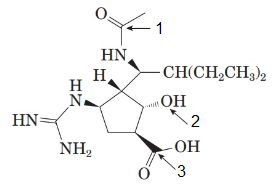
The labelled groups are as follows:
- Amide
- Alcohol
- Carboxylic acid
Here, nitrogen in the amide group and alcohol (hydroxyl group) both are secondary.
(c)
Interpretation:
The number of stereocenters present in peramivir should be determined.
Concept Introduction:
Stereocentre or chiral centre is the carbon centre when four different groups attached to it. For a molecule with n stereocenters, the number of stereoisomers can be calculated using the following formula:
Answer to Problem 43P
5 stereocenters.
Explanation of Solution
The structure of the molecule is as follows:
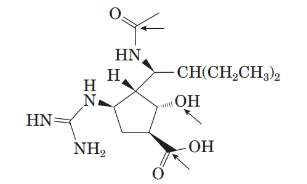
Stereocentre or chiral centre is the carbon centre when four different groups attached to it. All the stereocenters present in the compound are represented as follows:
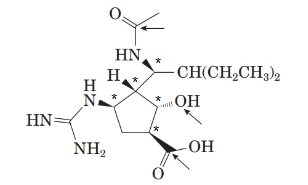
(d)
Interpretation:
The maximum number of stereoisomers should be calculated.
Concept Introduction:
Stereocentre or chiral centre is the carbon centre when four different groups attached to it. For a molecule with n stereocenters, the number of stereoisomers can be calculated using the following formula:
Answer to Problem 43P
32 stereoisomers.
Explanation of Solution
The number of stereocenters in the compound is 5.
Thus, maximum number of stereoisomers can be calculated as follows:
Putting the value,
Thus, there are 32 stereoisomers in the molecule.
(e)
Interpretation:
The number of enantiomers and diastereomers of peramivir should be determined.
Concept Introduction:
Enantiomers are two stereoisomers which are non-superimposable mirror image of each other. Two enantiomers of a compound have similar physical properties but the direction of rotation of polarized light is different. The interaction with the optical isomers of other compounds is also different for them.
Due to this, there are different biological effects of different enantiomers of a compound. Optical activity can be observed in pure enantiomers. They can be separated making use of a chiral agent.
Naturally, there is only one enantiomer possible for most of the chiral compounds which are biologically present. For example, glycine in amino acids.
Diastereomer.
They are stereoisomers which are not mirror image of each other. The following isomers comes under this category:
Meso compounds, E-Z isomers, cis-trans isomers etc.
They also have similar physical properties.
One should not confuse with the D- and L- notation of the isomers with commonly used d- and l- labelling.
(e)
Answer to Problem 43P
There are 12 enantiomers and 30 diastereomers of peramivir.
Explanation of Solution
For any molecule, number of enantiomers and diastereomers can be calculated as follows:
For even number of stereocenters, the number of enantiomers can be calculated as follows:
And, for odd number of stereocenters, the number of enantiomers can be calculated as follows:
Since, the number of stereocenters are 5, it follows the formula for odd.
Putting the value,
Thus, number of enantiomers will be 12.
Now, now of diastereomers can be calculated as follows:
Putting the value,
Thus, number of diastereomers will be 30.
(f)
Interpretation:
The stereocenter with R-Configuration should be identified.
Concept Introduction:
Peramivir is an antiviral drug which is used in the treatment of influenza. It is a neuraminidase inhibitor which inhibits the transition state of the influenza so that it does not produce new viruses from the infected cells.
Answer to Problem 43P
The stereocenter with R-configuration is represented as follows:
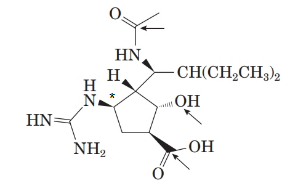
Explanation of Solution
The structure of molecule is as follows:
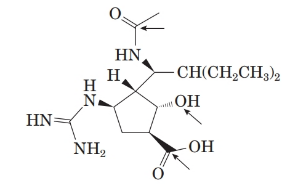
There are 5 stereoisomers in the above molecule labelled as follows:
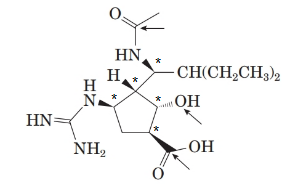
To name the molecule, the priory order for the atoms in ring will be:
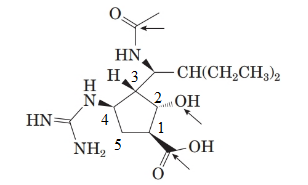
This is done by considering the functional group priority. Carboxylic acid gets the priority order one.
From the spectral data, chemical name of peramivir is ([1S, 2S, 3S, 4R]-3-[(1S)-1-(acetylamino)-2-ethylbutyl]-4-[(aminoiminomethyl)amino]-2-hydroxy cyclopentane carboxylic acid. Thus, the stereocenter at 4th position in the 5 membered ring has the r configuration.
Therefore, the stereocenter with R-configuration is represented as follows:
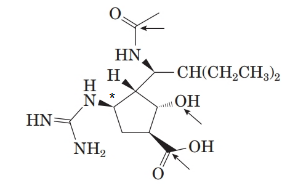
(g)
Interpretation:
The given molecules should be classified as identical, enantiomer, diastereomer and none of these.
Concept Introduction:
Enantiomers are two stereoisomers which are non-superimposable mirror image of each other. Two enantiomers of a compound have similar physical properties but the direction of rotation of polarized light is different. The interaction with the optical isomers of other compounds is also different for them.
Due to this, there are different biological effects of different enantiomers of a compound. Optical activity can be observed in pure enantiomers. They can be separated making use of a chiral agent.
Naturally, there is only one enantiomer possible for most of the chiral compounds which are biologically present. For example, glycine in amino acids.
Diastereomer.
They are stereoisomers which are not mirror image of each other. The following isomers comes under this category:
Meso compounds, E-Z isomers, cis-trans isomers etc.
They also have similar physical properties.
One should not confuse with the D- and L- notation of the isomers with commonly used d- and l- labelling.
Answer to Problem 43P
A- Identical.
B- Diastereomers.
C- Diastereomers.
D-Enantiomers.
Explanation of Solution
The structure of the peramivir is as follows:
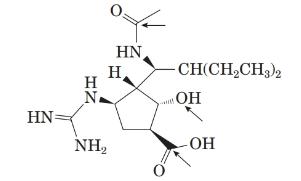
Comparing the molecular structure, A with the given structure of peramivir as follows:
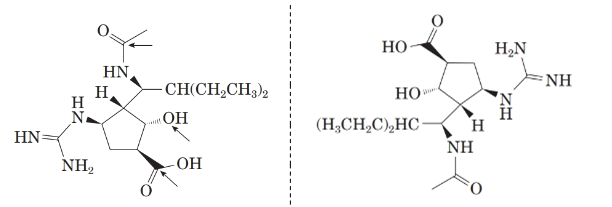
Both are not mirror image of each other. They are identical to each other. The second structure on the right-hand side formed by 180-degree rotation of the molecule given in left.
They are neither diastereomers nor enantiomers.
Now, comparing the molecular structure B with the given structure of peramivir as follows:
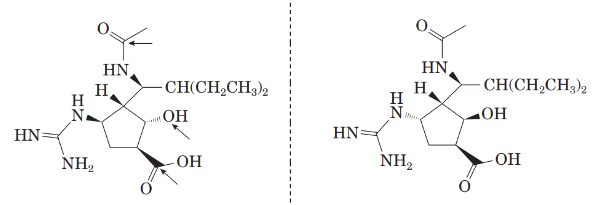
The molecules are not mirror image of each other. Thus, they are diastereomers.
Now, comparing the molecular structure C with the given structure of peramivir as follows:

They are not mirror image of each other. The molecules are diastereomers.
Now, comparing the molecular structure D with the given structure of peramivir as follows:
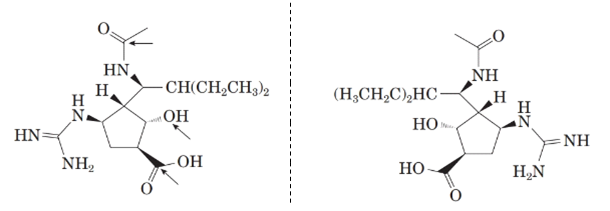
From the above figure, both the structures are mirror image of each other. Also, the mirror images are non-superimposable. Thus, they are enantiomers of each other.
Want to see more full solutions like this?
Chapter 18 Solutions
Introduction to General, Organic and Biochemistry
- The data for the potential difference of a battery and its temperature are given in the table. Calculate the entropy change in J mol-1 K-1 (indicate the formulas used).Data: F = 96485 C mol-1arrow_forwardIn a cell, the change in entropy (AS) can be calculated from the slope of the E° vs 1/T graph. The slope is equal to -AS/R, where R is the gas constant. Is this correct?arrow_forwardUsing the Arrhenius equation, it is possible to establish the relationship between the rate constant (k) of a chemical reaction and the temperature (T), in Kelvin (K), the universal gas constant (R), the pre-exponential factor (A) and the activation energy (Ea). This equation is widely applied in studies of chemical kinetics, and is also widely used to determine the activation energy of reactions. In this context, the following graph shows the variation of the rate constant with the inverse of the absolute temperature, for a given chemical reaction that obeys the Arrhenius equation. Based on the analysis of this graph and the concepts acquired about the kinetics of chemical reactions, analyze the following statements: I. The activation energy (Ea) varies with the temperature of the system. II. The activation energy (Ea) varies with the concentration of the reactants. III. The rate constant (K) varies proportionally with temperature. IV. The value of the…arrow_forward
- In an electrolytic cell, indicate the formula that relates E0 to the temperature T.arrow_forward-- 14:33 A Candidate Identification docs.google.com 11. Compound A can transform into compound B through an organic reaction. From the structures below, mark the correct one: HO A تھے۔ די HO B ○ A) Compounds A and B are isomers. B) Both have the same number of chiral carbons. C) Compound A underwent an addition reaction of Cl2 and H2O to form compound B. D) Compound A underwent a substitution reaction forming the intermediate chlorohydrin to obtain compound B. E) Compound A underwent an addition reaction of Cl2 forming the chloronium ion and then added methanol to obtain compound B. 60arrow_forward-- 14:40 A Candidate Identification docs.google.com 13. The compound 1-bromo-hex-2-ene reacts with methanol to form two products. About this reaction, mark the correct statement: OCH3 CH3OH Br OCH3 + + HBr A B A) The two products formed will have the same percentage of formation. B) Product B will be formed by SN1 substitution reaction with the formation of an allylic carbocation. C) Product A will be formed by SN1 substitution reaction with the formation of a more stable carbocation than product B. D) Product A will be formed by an SN2 substitution reaction occurring in two stages, the first with slow kinetics and the second with fast kinetics. E) The two compounds were obtained by addition reaction, with compound B having the highest percentage of formation. 57arrow_forward
- -- ☑ 14:30 A Candidate Identification docs.google.com 10. Amoxicillin (figure X) is one of the most widely used antibiotics in the penicillin family. The discovery and synthesis of these antibiotics in the 20th century made the treatment of infections that were previously fatal routine. About amoxicillin, mark the correct one: HO NH2 H S -N. HO Figura X. Amoxicilina A) It has the organic functions amide, ester, phenol and amine. B) It has four chiral carbons and 8 stereoisomers. C) The substitution of the aromatic ring is of the ortho-meta type. D) If amoxicillin reacts with an alcohol it can form an ester. E) The structure has two tertiary amides. 62arrow_forwardThe environmental police of a Brazilian state received a report of contamination of a river by inorganic arsenic, due to the excessive use of pesticides on a plantation on the riverbanks. Arsenic (As) is extremely toxic in its many forms and oxidation states. In nature, especially in groundwater, it is found in the form of arsenate (AsO ₄ ³ ⁻ ), which can be electrochemically reduced to As ⁰ and collected at the cathode of a coulometric cell. In this case, Potentiostatic Coulometry (at 25°C) was performed in an alkaline medium (pH = 7.5 throughout the analysis) to quantify the species. What potential (E) should have been selected/applied to perform the analysis, considering that this is an exhaustive electrolysis technique (until 99.99% of all AsO ₄ ³ ⁻ has been reduced to As ⁰ at the electrode, or n( final) = 0.01% n( initial )) and that the concentration of AsO ₄ ³ ⁻ found in the initial sample was 0.15 mmol/L ? Data: AsO ₄ 3 ⁻ (aq) + 2 H ₂ O ( l ) + 2 e ⁻ → A s O ₂ ⁻ ( a…arrow_forward-- 14:17 15. Water-soluble proteins are denatured when there is a change in the pH of the environment in which they are found. This occurs due to the protonation and deprotonation of functional groups present in their structure. Choose the option that indicates the chemical bonds modified by pH in the protein represented in the following figure. E CH2 C-OH CH2 H₂C H₁C CH CH3 CH3 CH CH₂-S-S-CH₂- 910 H B -CH2-CH2-CH2-CH₂-NH3* −0—C—CH₂- ○ A) A, C e D. • В) Вес ○ C) DeE ○ D) B, De E ○ E) A, B e C 68arrow_forward
- Suppose sodium sulfate has been gradually added to 100 mL of a solution containing calcium ions and strontium ions, both at 0.15 mol/L. Indicate the alternative that presents the percentage of strontium ions that will have precipitated when the calcium sulfate begins to precipitate. Data: Kps of calcium sulfate: 2.4x10 ⁻ ⁵; Kps of strontium sulfate: 3.2x10 ⁻ ⁷ A) 20,2 % B) 36,6 % C) 62,9 % D) 87,5 % E) 98.7%arrow_forward14:43 A Candidate Identification docs.google.com 14. The following diagrams represent hypothetical membrane structures with their components numbered from 1 to 6. Based on the figures and your knowledge of biological membranes, select the correct alternative. | 3 5 || 人 2 500000 6 A) Structures 1, 3, 5, 2 and 4 are present in a constantly fluid arrangement that allows the selectivity of the movement ○ of molecules. Structure 4, present integrally or peripherally, is responsible for this selection, while the quantity of 6 regulates the fluidity. B) The membranes isolate the cell from the environment, but allow the passage of water-soluble molecules thanks to the presence of 2 and 3. The membrane in scheme is more fluid than that in 55arrow_forward12. Mark the correct statement about reactions a and b : a. Br + -OH Br b. + Br H₂O + Br -OH + H₂O A) The reactions are elimination reactions, with reaction "a" being of type E2 and reaction "b" being of type E1. B) Reaction "a" is an E2 type elimination occurring in one step and reaction "b" is an SN1 type substitution. C) Both reactions can result in the formation of carbocation, but in reaction "b" the most stable carbocation will be formed. D) Both reactions occur at the same rate ○ and have the same number of reaction steps. E) Reaction "b" is an E2 type elimination occurring in two steps and reaction "a" is an SN2 type substitution.arrow_forward
 Chemistry: The Molecular ScienceChemistryISBN:9781285199047Author:John W. Moore, Conrad L. StanitskiPublisher:Cengage Learning
Chemistry: The Molecular ScienceChemistryISBN:9781285199047Author:John W. Moore, Conrad L. StanitskiPublisher:Cengage Learning Introduction to General, Organic and BiochemistryChemistryISBN:9781285869759Author:Frederick A. Bettelheim, William H. Brown, Mary K. Campbell, Shawn O. Farrell, Omar TorresPublisher:Cengage Learning
Introduction to General, Organic and BiochemistryChemistryISBN:9781285869759Author:Frederick A. Bettelheim, William H. Brown, Mary K. Campbell, Shawn O. Farrell, Omar TorresPublisher:Cengage Learning Introductory Chemistry: A FoundationChemistryISBN:9781337399425Author:Steven S. Zumdahl, Donald J. DeCostePublisher:Cengage Learning
Introductory Chemistry: A FoundationChemistryISBN:9781337399425Author:Steven S. Zumdahl, Donald J. DeCostePublisher:Cengage Learning


